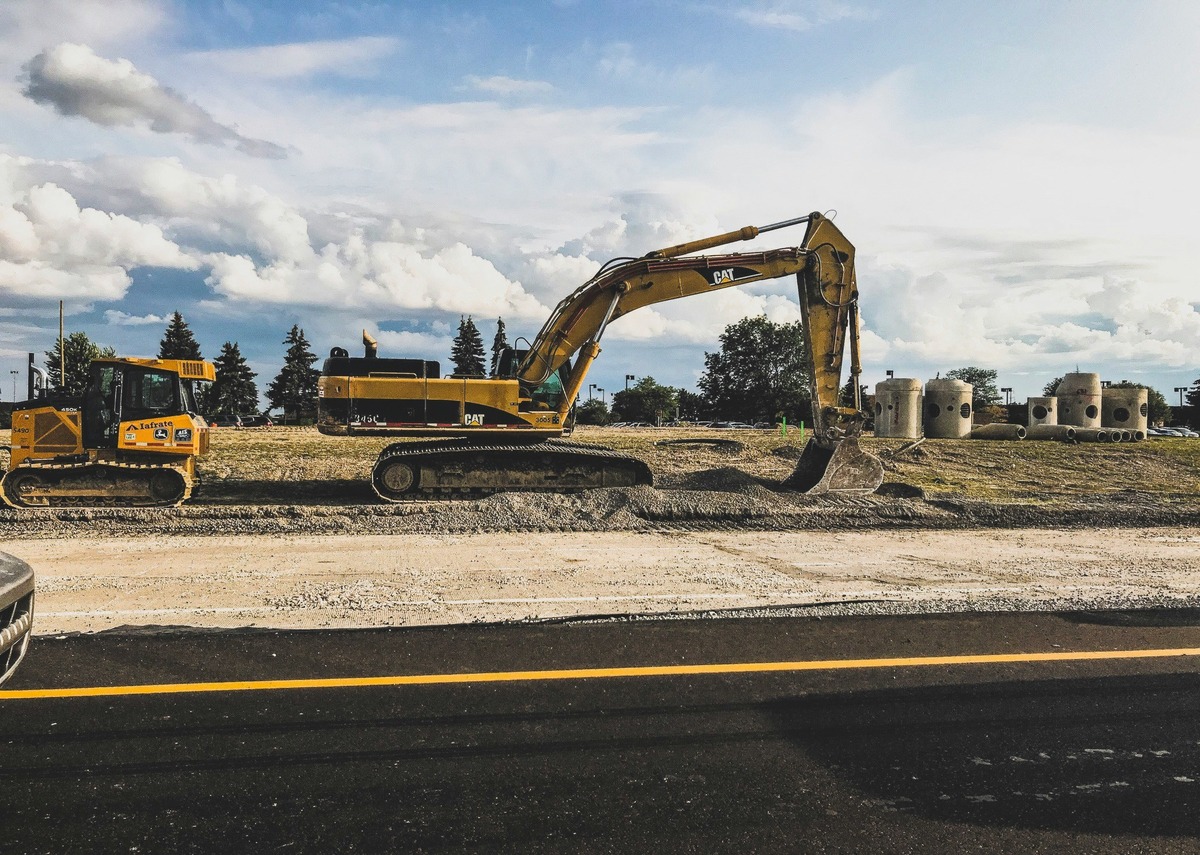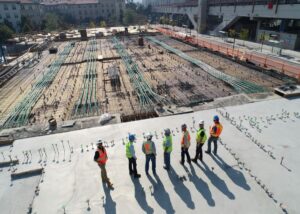Geotechnical engineers and technicians use specific kinds of tools and equipment to study or acquire information about different forms and construction of earth materials. This information is crucial for designing and constructing buildings, roads, foundations, earthworks, and oil rigs effectively. In this article, we will explore the necessary tools for geotechnical engineering and delve into excavation works and geotechnical engineering techniques to understand the essential aspects of successful construction projects.
Table of Contents
Key Takeaways
- Geotechnical engineers use specific tools and equipment to study earth materials for construction purposes.
- Understanding soil conditions is crucial for successful construction projects.
- Geotechnical engineering techniques involve novel construction methods and advances in soil mechanics.
- Geomechanical engineering and geology play vital roles in the success of construction projects.
- Proper assessment of soil properties is essential for effective geotechnical engineering.
Necessary Tools for Geotechnical Engineering

Environmental Tools
In the realm of geotechnical engineering, environmental tools play a pivotal role in ensuring that construction projects align with ecological standards and regulations. Advanced soil testing equipment is at the forefront of environmental assessment, providing critical data for informed decision-making. These tools help in identifying potential environmental impacts and in the development of mitigation strategies.
Environmental tools encompass a range of instruments and software designed for the collection and analysis of soil, water, and air samples. The following list outlines some of the key tools used in geotechnical labs:
- Portable soil gas analyzers
- Water quality testing kits
- Air sampling and monitoring devices
- Geotechnical software for environmental data analysis
It is essential to integrate environmental considerations early in the project planning phase to avoid costly delays and ensure compliance with environmental regulations.
Staying abreast of the latest innovations in geotechnical soil testing equipment is crucial. The industry is witnessing a surge in the development of advanced tools and techniques for precise soil analysis and geotechnical testing, which are instrumental in the success of construction projects.
Geotechnical Tools
In the realm of geotechnical engineering, the selection of appropriate tools is paramount for the accurate assessment and management of subsurface conditions. Geotechnical tools are essential for gathering data that informs the design and construction of stable structures. Among the various types of geotechnical equipment, some of the most commonly used include drilling rigs, surveying equipment, inclinometers, and data acquisition systems.
The use of these tools allows engineers to increase the bearing capacity of soils, mitigate risks such as liquefaction in sandy soils, and enhance the durability of soils under various environmental conditions.
To illustrate the diversity of geotechnical tools, here is a list of some key instruments and their functions:
- Drilling rigs: Obtain core samples for analysis
- Surveying equipment: Map and measure the site
- Inclinometers: Monitor slope stability
- Data acquisition systems: Collect and process geotechnical data
Each tool plays a critical role in ensuring the success of construction projects by providing the necessary information to make informed decisions.
Structural Tools
In the realm of geotechnical engineering, structural tools are indispensable for ensuring the integrity and longevity of construction projects. The proper selection and application of these tools can significantly influence the success of a project. Structural tools encompass a variety of instruments and software used to analyze and design structures that will stand the test of time and nature.
- Structural Analysis Software: Used for simulating and understanding the behavior of structures under various loads.
- Vibration Monitoring Equipment: Essential for assessing the impact of construction on surrounding structures.
- Load Testing Apparatus: Determines the load-bearing capacity of piles and foundations.
The synergy between advanced structural tools and expert analysis is crucial for predicting and mitigating potential issues before they escalate into costly problems.
Continual advancements in technology have led to the development of sophisticated tools that assist engineers in creating safer, more resilient structures. It is the responsibility of the geotechnical engineer to stay abreast of these innovations and to integrate them effectively into their practice.
Transportation Tools
In the realm of geotechnical engineering, transportation tools are pivotal for the successful execution of construction projects. These tools encompass a wide range of equipment and software designed to ensure the safe and efficient movement of materials, machinery, and personnel. Transportation tools are not just about mobility; they are about precision and reliability in the logistical aspect of construction.
One key aspect of transportation in geotechnical engineering is the use of heavy-duty vehicles. These include various types of trucks, cranes, and earth-moving equipment. Each vehicle is selected based on the specific needs of the project, such as load capacity, terrain navigability, and environmental considerations. For instance, cranes are essential for lifting and placing heavy geotechnical instruments or structural components with exactitude.
The integration of advanced technology in transportation tools has led to significant improvements in project efficiency and safety. Leveraging cloud technology and dynamic geotechnical graphing within workflows allows for real-time monitoring and adjustments, which is crucial in the fast-paced construction environment.
Another critical element is the software that supports transportation logistics. This includes programs for route planning, load optimization, and tracking of vehicles and equipment. Such software ensures that resources are utilized effectively, reducing waste and enhancing overall project management. The Geotechnical Engineering Podcast episode titled ‘How Geotechnical Engineering Software Transforms Infrastructure Projects’ highlights the transformative impact of these tools.
In summary, transportation tools in geotechnical engineering are indispensable for the seamless progression of construction projects. They provide the necessary support for the complex logistics involved in moving large volumes of earth, materials, and equipment, which is a cornerstone of successful construction.
Excavation Works

Geotechnical Considerations
In the realm of geotechnical engineering, understanding the subsurface conditions is paramount for the success of any construction project. Proper assessment of soil conditions is crucial to address potential challenges such as soil liquefaction, especially in earthquake-prone regions. Engineers must consider a variety of geotechnical parameters, including Poisson’s ratio, ground stiffness, and density changes to ensure the stability and longevity of structures.
The reinforcement of soils with low bearing capacity or high compressibility is essential to prevent damage to structures and to mitigate risks associated with natural phenomena like freeze-thaw cycles and seismic activities.
Key considerations for geotechnical engineers also include the analysis of soil composition, geological conditions, and environmental factors. These elements significantly influence the recommendations for construction designs and are vital for ensuring earthquake resilience. The following points highlight the importance of thorough soil liquefaction analysis:
- Understanding the risk of liquefaction in sandy soils to eliminate potential hazards.
- Increasing the durability of soils under extreme weather conditions.
- Ensuring the stability of lightweight structures and retaining structures built on clays with high swelling pressure.
Engaging with the latest research and advancements in geotechnical engineering allows professionals to stay informed and contribute to the field’s growth. Continuous learning and involvement in new geotechnical practices are key to navigating the engineering landscape with integrity and expertise.
Soil Condition Assessment
Assessing soil conditions is a critical step in geotechnical engineering, providing insights into the suitability of the soil for construction projects. Proper soil assessment ensures the longevity and safety of structures by identifying potential issues such as soil liquefaction risks, bearing capacity, and groundwater conditions.
The geotechnical aspects of soil testing include settlement analysis, soil classification, shear strength, and groundwater conditions, which are essential for determining the appropriate construction approach.
Soil stabilization and the prediction of unconfined compressive strength are also integral to soil condition assessment. Recent studies have shown remarkable improvements in soil properties through various enhancement techniques. For instance:
- 59.95% improvement in deviatoric stress ((\sigma_{dev}))
- 21.80% increase in cohesion
- 63% enhancement in internal friction angle
- 34.70% rise in equivalent axial compressive (EAC) values
These advancements underscore the importance of continuous research and the application of novel methods, such as machine learning models, to predict and improve soil behavior.
Task Performance
In the realm of geotechnical engineering, task performance is critically linked to the successful application of construction techniques and the minimization of environmental impact. Peak particle velocity (PPV), for instance, is a significant factor when considering the effects of blasting on nearby structures. A reliable prediction and control of PPV are paramount to prevent damage and ensure the integrity of the construction site.
PPV estimation is not only a technical necessity but also a regulatory requirement in many cases. The following table illustrates the comparative performance of two neuro-based metaheuristic models used for PPV prediction:
| Model Type | Prediction Accuracy | Use Case |
|---|---|---|
| Neuro-Imperialism | High | Tunnel Blasting |
| Neuro-Swarm | Moderate | General Blasting |
The geotechnical exploration is comprised of four primary tasks and applies to roadway, bridges, retaining walls, miscellaneous structures, and geohazards.
It is essential to integrate intelligent modeling techniques, such as artificial neural networks (ANN), to enhance the accuracy of predictions. These models are evaluated using several metrics to ensure their reliability in diverse construction scenarios.
Geotechnical Engineering Techniques

Novel Construction Techniques
The field of geotechnical engineering is continuously evolving with the introduction of novel construction techniques that aim to enhance efficiency and sustainability in construction projects. These innovative methods leverage advanced statistical techniques, hybrid-based intelligence, and optimized machine learning to tackle complex geotechnical challenges.
Embracing these novel techniques is crucial for the development of smart infrastructure construction, which integrates theory-guided machine learning and probabilistic methods to ensure reliability and risk mitigation in design and construction.
A notable trend is the shift towards more circular approaches in foundation construction, as highlighted by industry professionals on platforms like NextGenConstructionHub.com. This online resource provides construction professionals with exclusive content on innovative building solutions, featuring Procore analysis and social media links to foster a community of forward-thinking experts.
The following list outlines some key areas where novel construction techniques are making significant impacts:
- Smart infrastructure construction
- Theory-guided machine learning techniques
- Probabilistic and reliability methods
- Risk-based approach in design and construction
These advancements are not only theoretical but are being applied in real-world scenarios, such as the reinforcement of embankment surfaces for railway upgrades and the design and support of slopes and tunnels.
Metaheuristic Techniques
In the realm of geotechnical engineering, metaheuristic techniques have emerged as a powerful tool for solving complex optimization problems. These techniques, which include genetic algorithms, ant colony optimization, and particle swarm optimization, are particularly adept at finding near-optimal solutions in a reasonable timeframe. The adaptability of metaheuristics allows for their application across various construction challenges, ranging from soil condition assessment to structural design optimization.
Metaheuristic algorithms are often inspired by natural processes and are designed to navigate the search space efficiently. For instance, genetic algorithms mimic the process of natural selection, while ant colony optimization is based on the foraging behavior of ants. The following list highlights some of the key applications of metaheuristic techniques in geotechnical engineering:
- Optimization of foundation design
- Tunneling and underground space technology
- Soil and rock mechanics
- Smart infrastructure construction
The integration of metaheuristic techniques with advanced computational models has led to significant improvements in predictive accuracy and design efficiency. This synergy is particularly evident in the development of smart infrastructure, where adaptive algorithms contribute to more resilient and sustainable construction practices.
As the construction industry continues to evolve, tools like Procore are expected to play a pivotal role in enhancing project collaboration and providing advanced reporting and financial tools for construction professionals. The application of metaheuristic techniques in conjunction with platforms like Procore can lead to more efficient and effective construction processes, addressing the intricate demands of modern engineering projects.
Advances in Soil Mechanics
The field of soil mechanics has seen significant advancements, particularly in the realm of predicting and enhancing soil behavior for construction purposes. Machine learning models have been optimized to forecast the unconfined compressive strength in fine-grained soil, a critical factor in ensuring stability and safety in construction projects.
Recent studies have focused on the application of novel statistical and computational techniques to better understand soil properties. For instance, the use of Multivariate Adaptive Regression Splines (MARS) has improved the analysis of anchor uplift capacity in spatially varying soil, which is vital for secure foundation engineering.
The integration of traditional soil reinforcement methods with cutting-edge technology has led to more reliable and efficient construction practices.
The following list highlights key areas where soil mechanics has evolved:
- Application of optimized machine learning techniques
- Development of theory-guided machine learning models
- Enhanced understanding of soil and rock mechanics through advanced statistical techniques
- Improved soil reinforcement technology using natural plant fiber materials
These developments are not only theoretical but have practical implications, as seen in the enhanced project collaboration and advanced reporting tools available to construction professionals in platforms like Procore.
Geomechanical Engineering
Geomechanical engineering is a pivotal field within geotechnical engineering, intertwining the principles of geology and mechanics. It is instrumental in addressing the challenges associated with the mechanical behavior of geological materials. Geomechanical engineering provides critical insights into the design and analysis of structures that interact with soil and rock.
The application of geomechanical principles is essential for ensuring the stability and longevity of various structures. It involves the assessment of soil and rock properties, which are crucial for predicting and mitigating potential geotechnical failures. Techniques such as rock mechanics and tunneling are often employed to navigate complex subsurface conditions.
The integration of advanced statistical and hybrid-based intelligence techniques is revolutionizing the field, offering more accurate and reliable predictions for construction projects.
Here are some key areas of focus in geomechanical engineering:
- Advanced statistical techniques
- Hybrid-based intelligence techniques
- Tunneling and underground space technology
- Foundation engineering
- Surface and deep excavation
- Smart infrastructure construction
For more insights and updates on the latest trends in geomechanical engineering, consider subscribing to resources like NextGenConstructionHub.com, which offers a construction management blog, contact form, and social media links.
Geology and Geophysics
Geophysics, a cornerstone of geotechnical engineering, leverages a variety of tools to conduct comprehensive ground investigations. These tools help delineate the properties of subsurface materials and detect changes beneath the Earth’s surface. Ground-penetrating radar (GPR), for instance, has been instrumental since its inception for tasks such as measuring glacier thickness.
Why and when to use geophysics are critical considerations. Geophysics enhances the understanding of a site by providing data on the variation of physical properties across an area. This can be a vertical profile to a certain depth or the topography of the near-surface layer. It is essential to apply geophysical methods appropriately to ensure they complement other investigative techniques, such as boreholes and trial pits.
The synergy between geophysical surveys and intrusive investigations can yield a more comprehensive understanding of subsurface conditions. Identifying and mapping geophysical anomalies can lead to more effective site remediation strategies.
The table below summarizes the key aspects of geophysics in geotechnical engineering:
| Aspect | Description |
|---|---|
| Tools | Non-invasive methods like GPR |
| Application | Mapping physical property changes |
| Integration | Complements intrusive methods |
| Outcome | Enhanced site remediation strategies |
Conclusion
In conclusion, geotechnical engineering plays a crucial role in the successful construction of various structures and infrastructure projects. By utilizing a range of specialized tools and equipment, geotechnical engineers and technicians are able to gather essential information about the earth’s materials and conditions, enabling them to make informed decisions during the design and construction phases. The advancements in geotechnical techniques, soil mechanics, and geomechanical engineering have revolutionized the field, allowing for more efficient and sustainable construction practices. As we continue to explore the dynamic intersection of earth science, geology, and mechanics in geotechnical engineering, it becomes evident that the future of construction heavily relies on the expertise and innovation within this discipline.
Frequently Asked Questions
Why is geotechnical engineering important in construction?
Geotechnical engineering is crucial in construction as it helps assess soil conditions, determine foundation design, and ensure the stability and safety of structures built on the earth’s surface.
How do geotechnical engineers assess soil composition and geological conditions?
Geotechnical engineers assess soil composition and geological conditions through various methods such as drilling, sampling, laboratory testing, and geophysical surveys to understand the properties of the soil and rock layers.
What are the key challenges faced by geotechnical engineers in extreme weather conditions?
Geotechnical engineers face challenges in extreme weather conditions such as soil erosion, slope stability issues, and foundation settlement due to factors like heavy rainfall, freeze-thaw cycles, and high winds.
What role does geotechnical engineering play in pavement design?
Geotechnical engineering plays a crucial role in pavement design by analyzing soil properties, traffic loads, and environmental factors to recommend suitable pavement materials, thickness, and construction techniques for durable and safe roads.
How do traditional reinforcement techniques benefit geotechnical engineering applications?
Traditional reinforcement techniques in geotechnical engineering help increase soil bearing capacity, reduce settlements, prevent damage to structures on unstable soils, and enhance soil durability under various conditions like freeze-thaw cycles and liquefaction risks.
What is the significance of geotechnical engineering in civil engineering projects?
Geotechnical engineering is essential in civil engineering projects to ensure the stability, safety, and longevity of structures by providing insights into soil behavior, foundation design, and construction methods tailored to the site’s geological and environmental conditions.






Pingback: Unseen Lifelines: How Hidden Subterranean Utilities Shape City Survival
Pingback: Understanding Earthquake Resistant Structures: Insights from a Geotechnical Engineer
Pingback: 10 Best AI Software Being Used in the Construction Industry 2024